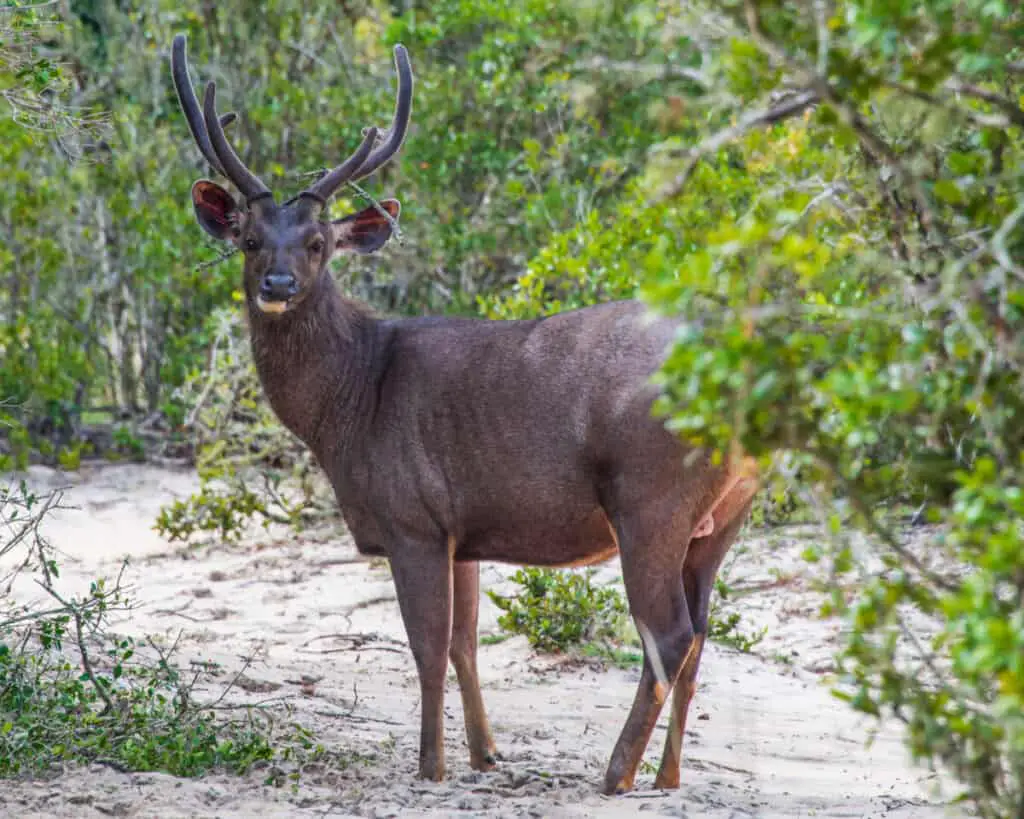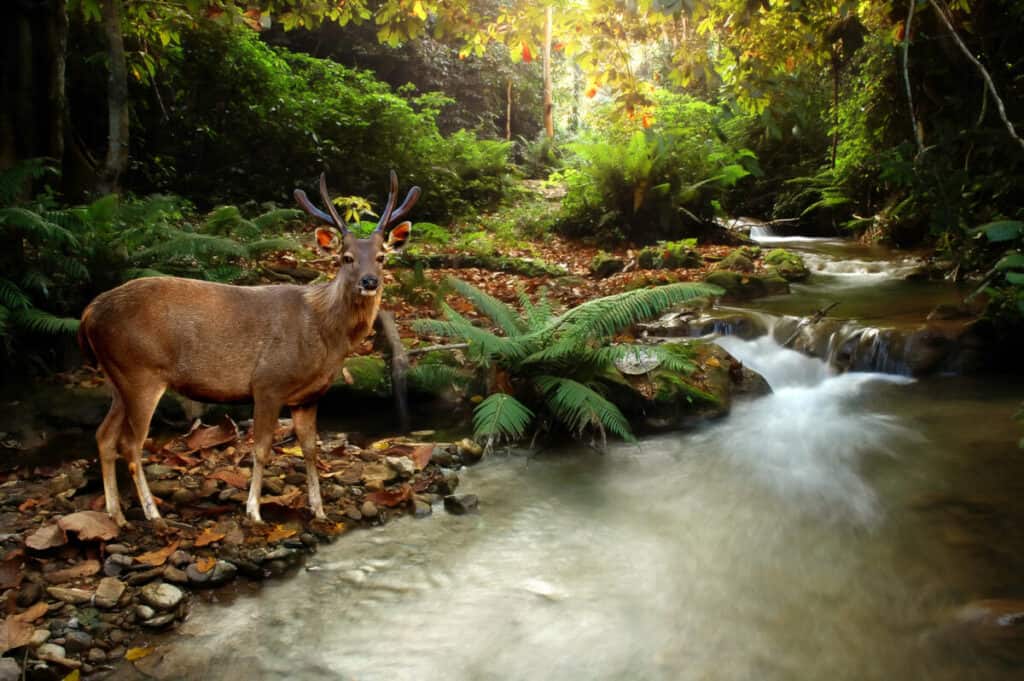Sambar (Rusa unicolor) is a large deer species found in the Indian subcontinent, Southeast Asia, and southern China. It is one of the largest members of the genus Rusa and typically inhabits forested areas near water sources such as rivers, marshes, or swamps. The sambars have an impressive physical appearance with their muscular bodies that can weigh up to 600 kg depending on sex and age.
The sambar has been a subject of research for many years due to its ecological significance and cultural value. This animal plays an essential role in shaping the ecosystem by influencing vegetation dynamics through browsing and aiding seed dispersal. Sambars also serve as food for predators like tigers, leopards, wild dogs, crocodiles, pythons, jackals, and hyenas.
Moreover, they hold significant religious importance in Hinduism where they are considered sacred animals associated with Lord Shiva.
In this article, we will explore various aspects of sambar including its taxonomy, morphology, distribution range, habitat preferences, behavior patterns as well as conservation status.

Taxonomy And Classification
The sambar (Rusa unicolor) is a large deer species that belongs to the family Cervidae. This animal is widely distributed throughout southern and southeastern Asia, including India, Sri Lanka, Indonesia, Malaysia, Thailand, and Vietnam.
The evolutionary history of the sambar can be traced back to about 1.5 million years ago when this deer lineage diverged from other members of the Cervidae family. Based on molecular data, it has been suggested that the genus Rusa evolved in Southeast Asia during the Pliocene epoch.
Despite its widespread distribution across multiple countries and regions, genetic diversity within sambar populations is relatively low due to their high levels of gene flow and limited geographic isolation. However, studies have shown some degree of differentiation among populations living in geographically isolated areas such as islands or mountain ranges.
Genetic analyses have also revealed potential hybridization events between sambar and closely related species such as Eld’s deer (Panolia eldii). Overall, understanding the evolutionary history and genetic diversity of the sambar provides important insights into its conservation status and management strategies in different parts of its range.
Morphology And Physical Characteristics
The sambar is a large deer species that inhabits the forests of South Asia, Southeast Asia and parts of East Asia. These majestic animals are characterized by their impressive antlers, which can grow up to 110 centimeters in length.
The fur on their body ranges from reddish-brown to dark brown, while their underbelly and throat are lighter in color. They also have distinctive white spots located near their ears.
Adaptations for survival play a crucial role in the life of sambars. Their size makes them less vulnerable to predators such as tigers and leopards, but they still need to be cautious when out in the open. One strategy they use is staying close to water sources like rivers or lakes where they can easily escape if danger arises.
Sambars also have excellent hearing and vision, allowing them to detect potential threats from afar. When it comes to hunting and predation strategies, sambars tend to be solitary creatures who prefer the cover of darkness. They move slowly through dense vegetation using their sharp senses until they find suitable prey like fruits, leaves or grasses.
Distribution And Habitat
Morphologically, the sambar is a large deer species that exhibits sexual dimorphism. Adult males have larger antlers compared to females and can weigh up to 600 kg while females are lighter at around 200-250 kg. Their coat color varies depending on their geographical location, but generally, they have dark brown fur with white spots on their underbelly. Sambar deer also possess a unique characteristic of having three-pronged antlers rather than two prongs like other deer.
Despite being hunted for their meat and antlers, sambars still thrive in various regions across Asia. They exhibit adaptations to survive such as having keen senses, powerful legs which allow them to run fast and jump high over obstacles when threatened by predators. Populations of sambars are highest in India where they inhabit forests, marshes, grasslands, and even higher altitudes whereas in Southeast Asia populations are declining due to habitat loss caused by deforestation and hunting pressure.
| Range | Population |
|---|---|
| India | High |
| Nepal | Medium |
| Myanmar | Declining |
| Thailand | Low |
Sambar deer’s range extends from the Indian subcontinent eastward through mainland Southeast Asia into China. In these regions, sambars occupy diverse habitats ranging from dense tropical forests to open grasslands or alpine meadows.
Despite facing threats from human activities like poaching and habitat loss due to agriculture expansion or logging operations, some populations of sambars remain stable mainly because of their ability to adapt and survive in different environments.
Sambars can change their feeding habits according to seasonal availability of food resources; during dry seasons when water sources become scarce, they tend to eat leaves instead of fruits or flowers. Moreover, sambars can live solitary lives or form small groups called “harem” consisting of one male and several females along with young offspring for protection.

Behavior And Social Patterns
Sambar deer are known for their unique social hierarchy and communication methods. The species exhibits a clear dominance structure, with mature males occupying the highest rank in the herd.
Females also have a hierarchical order within their groups, which is typically determined by age and reproductive status. Juvenile sambar live in small groups with other young individuals until they reach maturity.
Communication among sambar is primarily non-vocal, relying on body language and scent marking to convey information between individuals. Dominant males use visual displays like antler displays or erecting hair as an aggressive display to assert dominance over subordinate individuals within the group. Additionally, olfactory cues play a critical role in communication, particularly during mating season when dominant males mark territories with urine and scent glands to attract females.
Overall, these complex social structures of sambar contribute significantly to its evolutionary success as a species that thrives across multiple habitats throughout Asia.
The intricate social patterns observed in sambar highlight how animals develop sophisticated systems of interaction that allow them to thrive in diverse environments. By understanding these behaviors, researchers can gain insight into how different ecological factors influence animal behavior and evolution over time.
Ecological Significance And Role In Ecosystems
The sambar deer, also called the Indian stag, is a keystone species in many ecosystems across its range. It plays an essential role in maintaining population dynamics by serving as both predator and prey.
As a herbivore, it feeds on a wide range of vegetation, including grasses, leaves, shoots, fruits, and bark. Its grazing behavior has significant implications for plant communities’ structure and composition because it helps maintain open spaces that promote light penetration to lower levels.
Predator-prey interactions involving the sambar are critical drivers of ecosystem processes such as nutrient cycling and energy flow. The animal’s unique anti-predator adaptations have evolved over time due to these interactions with predators such as tigers, leopards, dholes (Indian wild dogs), and other large carnivores. These adaptations include keen senses of hearing and smell, camouflage techniques like blending into their environment or standing motionless when detected by a predator, running at high speeds to escape danger quickly.
Overall, the ecological significance of the sambar cannot be understated -it serves as an indicator species whose presence can indicate habitat quality; its loss could lead to cascading effects throughout ecosystems where they occur.
Population dynamics must be considered when managing wildlife populations since changes in one species’ abundance will affect others within the same community.
In conclusion, although much research remains necessary regarding this elusive creature’s ecology and management practices that ensure long-term conservation success while meeting human needs for resources from natural areas inhabited by sambars- scientists agree there is no doubt about how crucial they are for sustaining healthy ecosystems around them!
Conservation Status And Threats
The conservation status of this South Asian deer species paints a bleak picture as their population decline continues at an alarming rate. The primary threat to sambar populations is human-wildlife conflict, where these animals come into contact with humans resulting in injury or death for both parties involved. Additionally, deforestation and agricultural expansion have led to a loss of suitable habitats for these creatures.
As such, urgent action needs to be taken by governments and conservation organizations alike to protect these iconic animals before they are lost forever. A concerted effort must be made towards implementing measures that mitigate human-wildlife conflict while also ensuring sustainable land use practices that preserve essential wildlife habitats. Only then can we hope to safeguard the future of the magnificent sambar and prevent them from becoming another casualty of human encroachment upon nature.
Increased public awareness campaigns about the importance of wildlife conservation, stricter enforcement laws against illegal hunting and poaching activities, collaborative efforts between nations to promote regional conservation programs, and implementation of sustainable development practices to reduce the negative impact of human activities on wildlife habitats are all necessary steps towards achieving this goal.
Conclusion
The sambar (Rusa unicolor) is a large deer species found across Asia.
Its taxonomy and classification have been subject to debate, with some experts considering it as a subspecies of the red deer.
The sambar has distinctive physical characteristics such as a dark brown coat, large ears, and long antlers in males.
Sambar populations are distributed from India to Southeast Asia and can thrive in diverse habitats ranging from tropical rainforests to grasslands.
They are primarily herbivorous and play an essential role in shaping plant communities by browsing on vegetation.
Despite their ecological significance, the conservation status of sambars varies depending on their geographic location.
In some areas like Thailand and Malaysia, they are classified as endangered due to habitat loss and hunting pressures.
Conversely, sambars in other regions like India and Sri Lanka are abundant but face challenges from human-wildlife conflicts.
One intriguing fact about sambars is that they have a unique vocalization system that includes barking, whistling, or snorting sounds used for communication between individuals.
This behavior adds another layer of complexity to our understanding of this fascinating animal’s social patterns.
As we continue to learn more about these creatures’ biology and ecology, there is hope that effective conservation measures will be put in place to secure their future survival.

